
Mediterranean Garden Society

Mediterranean Garden Society
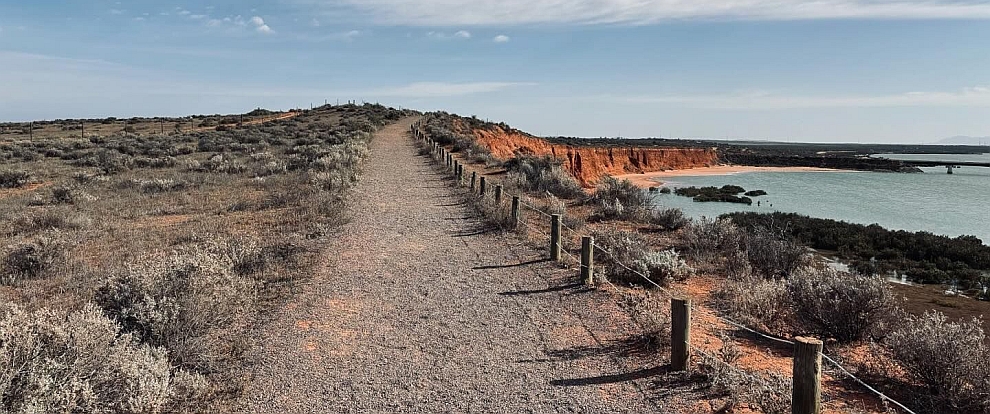
by Ann Beisch
Photographs by Willem-Jan Kuiper, Ann Beisch and Chris Kirby
Photographs to illustrate the article published in The Mediterranean Garden No. 119, January 2025
The photo at the top of this page shows the Arid Lands Botanical Garden at Port Augusta (photo Willem-Jan Kuiper)
She is not beautiful. But she is awe-inspiring, spectacular and omnipotent in her expanse of desert land stretching out to a ribbon of red horizon. It is a landscape of salt bush, Rhagodia spincscens, and black bluebush, Maireana pyramidata, thriving throughout. This is South Australia’s arid land in springtime.
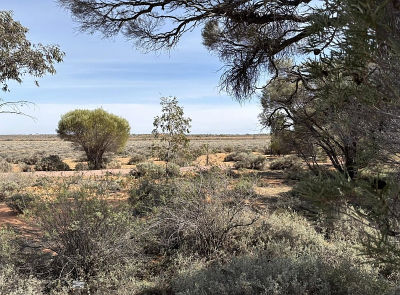
Salt bush landscape (Willem-Jan Kuiper)
In October 2024, the South Australia Branch of the Mediterranean Garden Society welcomed MGS members from around the world to tour the stark and vast deserts below the Flinders Ranges, within the Australian Arid Lands Botanic Garden, along the gulf seashore and through the Horrocks Pass on an amazing four-day desert pre-tour, before the main Adelaide tour later in the month.
The members of the South Australia Branch of the MGS welcomed us in Adelaide and did an amazing job of introducing, educating us about and, most of all, celebrating their South Australia desert lands.
In her novel The Sun Walks Down, Australian author Fiona McFarlane captures the essence of what we experienced when she writes of a six-year-old boy missing after a dust storm, “The country he walked into was red and brown—desert country— but there was a haze of green over the top of it, because it was spring.”
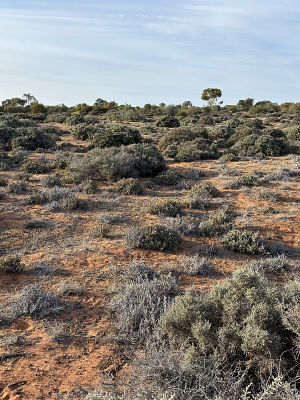
Endless desert land (Ann Beisch)
We travelled north from Adelaide to Kadina and Port Pirie towards the Mid-North deserts of South Australia. Vast spreads of desert land covered in spiny saltbush, Rhagodia spinescens, broombush, Melaleuca uncinata, and bluebush, Maireana sedifolia, spread out on both sides of the road, seemingly endless until a couple of kangaroos made a surprise showing in the distance.
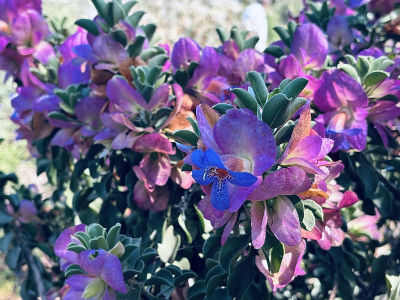
Tim and Sandra Wood’s garden (WJK)
Arriving in Kadina, we visited two private gardens with an emphasis on the native Australian flora. Tim and Sandra Wood’s garden was filled with native Eremophila whose tubular flowers were blooming red and hot pink. In Jan White’s garden, the problem of aging native gum trees, Eucalyptus camaldulensis, resulted in replanting and the creation of intimate restful spots where those giant trees once stood. In both cases, the gardens were designed to adapt to the scarcity of water, poor limestone soil conditions and hot, dry summers, with beautiful results.
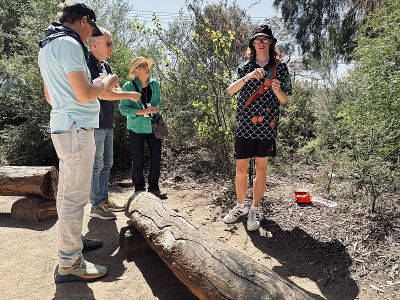
JPSS student introducing us to the Urumbula Garden (WJK)
Indigenous Australian student volunteers at the John Pirie Secondary School in Port Pirie showed us the Urumbula Garden, which is an Aboriginal Plant Use Garden. The students introduced us to some of the edible plants used by Indigenous Australians including the local Nukunu people. These treats included quandong, Santalum acuminatum, a small red stone fruit, the red rod emu bush, Eremophila calorhabdos, and finger lime, Citrus australasica, which we sampled.
Later a delightful, very English-style lunch was served at the clubhouse of the Port Pirie branch of the South Australian Country Women’s Association. This was founded in 1929 to address the poor quality of life and limited services for rural women and their children.
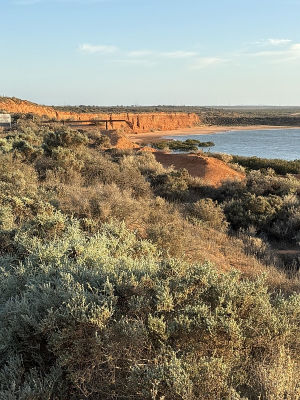
Dawn on the Upper Spencer Gulf (AB)
On our second day, we began in Port Augusta, driving along the shores of the Upper Spencer Gulf with views of the ancient red Flinders Ranges. We arrived just after sunrise to go birding in the Australian Arid Lands Botanic Garden. After a quick breakfast under the trees, our most important part of the tour began as we explored this amazing botanic garden.
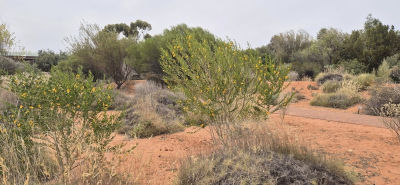
Petalostylis at Arid Lands (WJK)
The Australian Arid Lands Botanic Garden was dedicated in 1996 to promote, study and conserve the native plants of Australia’s arid southern regions. The 250-hectare garden incorporates a number of regions within South Australia. These sections of the garden present an intense study of, for example, the West Coast Mallee Region and the Flinders Ranges Region.
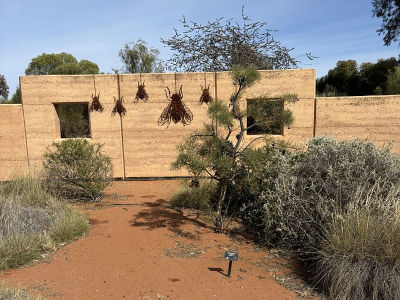
Visitor centre at Arid Lands (AB)
Mallee is defined as those eucalypts with a multi-stemmed habit and the areas of vegetation that surround them. This section of the garden reflected a wide variety of eucalypts with shrubland dominating this environment. These mallees are fire-tolerant and produce new shoots from the lignotuber after a fire.
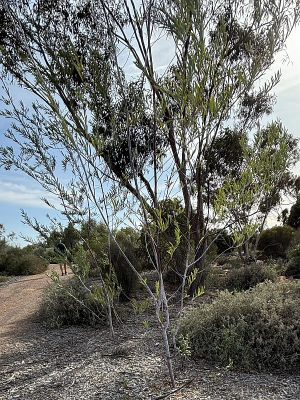
The native Chalky Whites (Acacia cretacea) at Arid Lands (AB)
In Southern California, where I come from, the eucalyptus species one sees are Australian imports. It was thus very exciting for me to see these bushes and trees in their home environment.
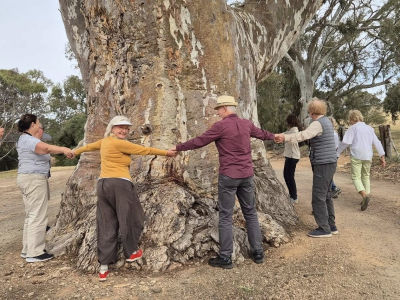
River Red Gum ‘Brewery Tree’ Eucalyptus camaldulensis at Melrose - eleven person hug
In the Australian Arid Lands Botanic Garden and throughout the region, seeing the large-fruited mallee, Eucalyptus youngiana, the curly mallee, Eucalyptus gillii, and the river red gum, Eucalyptus camaldulensis, in their natural environment as well as the multiple-stemmed, bushy Eucalyptus stricta was special. Many of these eucalypts are found only in botanic gardens in California.
The following day we crossed the Flinders Ranges through the Horrocks Pass to arrive at the mining town of Burra, a once thriving centre for copper mining. The terraced open-pit mines of Burra are like scars across the land, abandoned and slowly being reclaimed by nature.
The private gardens visited delighted the senses with their colours and scent and the joy of the gardeners who own them.
Roger Boehm’s 1848 Georgian-style house is an integral part of the extensive terraced garden that surrounds it. We toured his antique collections, saw his horse and carriage and admired the exuberantly flowering spring planting inside and outside his home. This garden was begun in the 1990s and, as in most private gardens in this region, the limestone ground required topsoil and water.
The garden of Stuart Maitland and Rod Roe is their weekend getaway designed to be a refuge from the city. Begun in 2021, it is a flourishing stylish mixture of native and other plants with a spread of native grasses. Large bowls of cheerful pansies welcomed visitors.
Lunch in a converted railway carriage in Burra’s old railroad station was a step back in time and gentility.
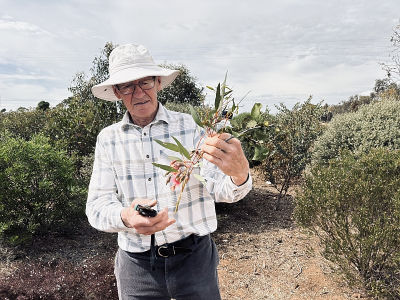
Ian Roberts at the Terrace Garden (WJK)
Our final day, at the Terrace Garden in Blyth, was a fitting close to our arid land tour. This roadside planting just outside the town is a labour of love by the community and the volunteer group Friends of The Terrace. Its theme is the Australian native flora and especially the study of those plants that can survive harsh summers with little water. This public space had twin-leaf emu bush, Eremophila oppositifolia, flowering throughout.
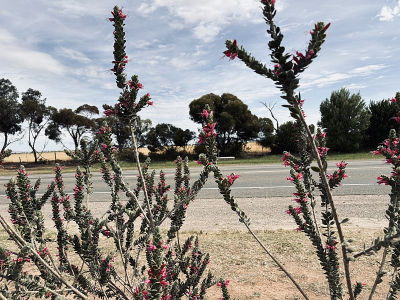
Eremophila calorhabdos denticulata on the roadside Terrace Garden (WJK)
It was begun in 2020 and founding member Ian Roberts explained how over 1400 native plants were brought in with an emphasis on limited water use and species survival. The land we walked on at the Terrace Garden was dry and shrunken with deep fissures throughout the grounds.
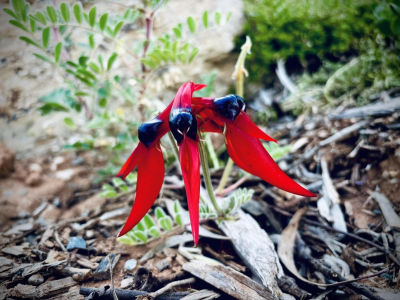
Sturt’s Desert Pea, Swainsona formosa (WJK)
In the town of Blyth we saw fully blooming Sturt’s Desert Pea, Swainsona formosa, a stunning spring flower that is the floral emblem of South Australia.
The programme ended with a special reception at Government House in Adelaide, surrounded by a manicured, lush Australian native plant landscape.
The South Australia Branch organisers did a wonderful job of keeping the group well informed, inspired and welcomed throughout. Experts explained what we would be seeing.
Special recognition goes to the presenter, John Zwar, founding member and former director of the Australian Arid Lands Botanic Garden who was a delight to listen to. Special thanks go too to the MGS Pre-Tour organisers led by Branch Head Mark Barnett and his fellow organisers Anne-Marie Holland, Kerry White, Kris Kirby, John Zwar and Anne Johnson
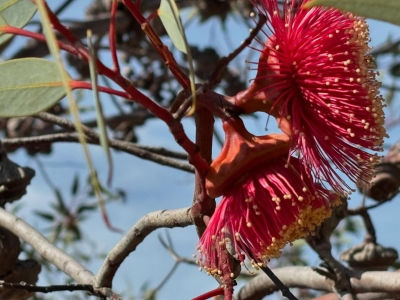
Eucalyptus youngiana at Australian Arid Lands Botanic Garden (WJK)
References
• Nayda, Chris. Plants of the Australian Arid Lands Botanic Garden, Friends of the Australian Arid Lands Botanic Garden, Port Augusta, 2015.
• McFarlane, Fiona. The Sun Walks Down. Farrar, Straus and Giroux. New York, 2022.
• Significant and endemic plant Species on low ranges and hills (pdf)
• Arid Lands Botanical Garden
• Wadlata Outback Centre, Port Augusta
THE MEDITERRANEAN GARDEN is the registered trademark of The Mediterranean Garden Society in the European Union, Australia, and the United States of America